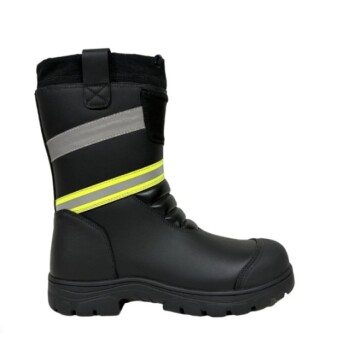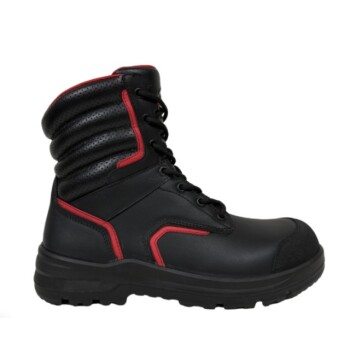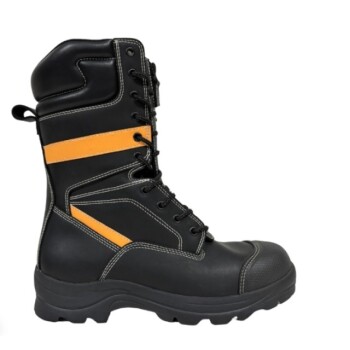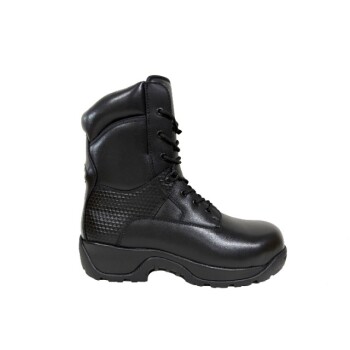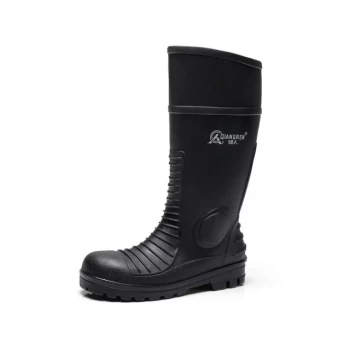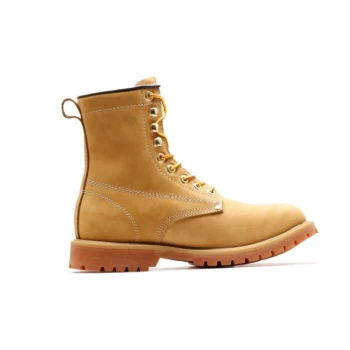At their core, engineer boots are a specific, historical style of work boot, while the term "work boot" is a broad category encompassing many designs. Engineer boots are defined by their laceless, pull-on design with a buckle at the top of the shaft and another across the instep. General work boots, in contrast, come in countless styles (lace-up, pull-on, etc.) and are primarily defined by their protective features for specific job site hazards.
The key distinction is specificity versus category. An engineer boot is a type of boot with a distinct, vintage silhouette. A work boot is defined by its function and safety features, which can take many forms.
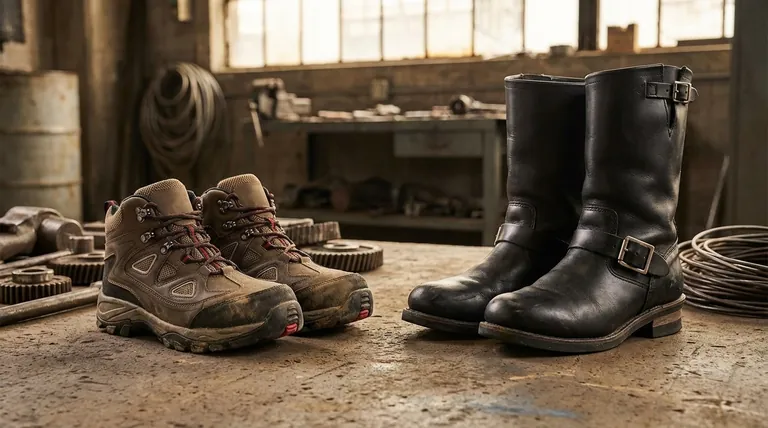
The Purpose-Built Design of a Work Boot
Work boots are tools for your feet. Their design is driven entirely by the need for safety and durability in demanding environments. This focus on function leads to a wide variety of specialized features.
A Focus on Hazard Protection
Modern work boots are engineered to protect against specific industrial risks. This includes features like steel or composite safety toes to guard against impacts and compression.
They often incorporate puncture-resistant plates in the sole to stop nails and other sharp objects. Additionally, slip-resistant rubber outsoles are standard for maintaining traction on slick or uneven surfaces.
Specialization for the Task
The "work boot" category is vast because different jobs have different needs. For example, boots for electricians may have electrical hazard (EH) rated soles, while firefighters wear boots designed to withstand extreme heat.
Boots made from PVC are common in wet or chemical-heavy environments due to their waterproof and chemical-resistant properties. This level of task-specific design is the hallmark of a true work boot.
The Classic Profile of an Engineer Boot
Engineer boots were born from a specific need during the age of steam locomotives. They were designed to protect the feet of firemen (engineers) who shoveled coal into train engines.
A Hybrid of Form and Function
The design combines the tall, protective shaft of a riding boot with the supportive sole of a work boot. This laceless, pull-on style prevented laces from getting caught in machinery, a significant hazard.
The defining visual features are the buckle at the top of the shaft to adjust the fit around the calf and a second buckled strap across the instep to secure the heel.
The Shift from Utility to Style
While originally built for a demanding job, the engineer boot's rugged and distinct appearance was adopted by motorcyclists and various subcultures.
Today, they are often considered a style choice as much as a functional one. While many are still built with durable materials, they typically lack the certified safety features (like steel toes or puncture resistance) found in modern industrial work boots.
Understanding the Trade-offs
Choosing between these boots requires understanding what you gain and what you give up with each style. The core trade-off is between certified safety and specific aesthetics.
Work Boots: Safety Over Style
The primary purpose of a modern work boot is to meet or exceed safety standards. This often means they are heavier and more utilitarian in appearance. Their design is dictated by function, not fashion trends.
Engineer Boots: Style Over Certified Safety
The classic engineer boot prioritizes a specific historical look. While well-made versions are durable, they are not a substitute for a certified safety boot on a regulated job site. They lack the specialized protective elements required for most industrial work today.
Making the Right Choice for Your Goal
Your decision should be guided by your primary need—certified protection for a job site, or a durable, classic style for general wear or riding.
- If your primary focus is workplace safety: Choose a modern work boot that is certified for the specific hazards you will face, such as those with steel toes, EH ratings, or puncture resistance.
- If your primary focus is motorcycle riding: A purpose-built motorcycle boot is the safest choice, but many riders prefer the classic aesthetic and durability of a high-quality engineer boot.
- If your primary focus is a rugged, timeless style: The engineer boot offers a distinct and iconic silhouette that has been a staple of heritage fashion for decades.
Ultimately, understanding the original purpose of each boot clarifies its modern role and helps you select the right tool for the job.
Summary Table:
| Feature | Engineer Boots | Work Boots |
|---|---|---|
| Primary Focus | Style, Heritage Aesthetics | Certified Safety, Hazard Protection |
| Key Design | Laceless pull-on with buckles | Lace-up or pull-on, various styles |
| Safety Features | Durable, but typically lacks certified toes/plates | Steel/composite toes, puncture-resistant soles, EH ratings |
| Best For | Motorcycle riding, heritage fashion, general wear | Industrial job sites, construction, electrical work |
Need Durable, High-Quality Footwear for Your Business?
As a large-scale manufacturer, 3515 produces a comprehensive range of footwear for distributors, brand owners, and bulk clients. Whether you need certified safety work boots for industrial use or stylish engineer boots for the fashion market, our production capabilities encompass all types of shoes and boots.
Partner with us to:
- Access a vast catalog of reliable and stylish footwear.
- Benefit from large-scale manufacturing efficiencies and competitive pricing.
- Receive custom solutions tailored to your brand and market needs.
Let's discuss your specific requirements — Contact our team today to get started!
Visual Guide
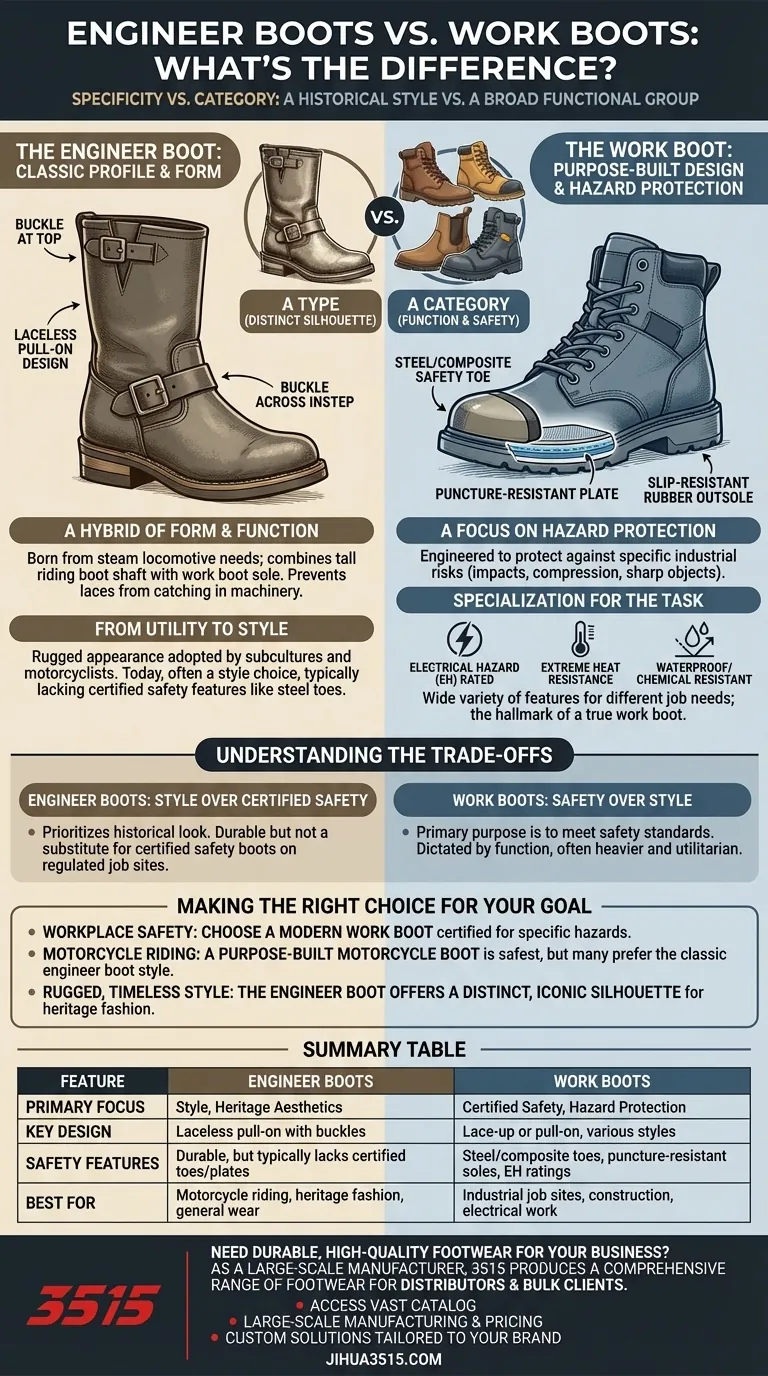
Related Products
- Safety Footwear Wholesale Manufacturer for Custom OEM/ODM Production
- Wholesale Safety Footwear Manufacturer for Bulk & Custom OEM Orders
- High Performance Fire-Retardant Waterproof Safety Boots
- Wholesale Mesh Steel Toe Safety Shoes with Dial Closure Factory Production
- Premium Wholesale Waterproof Safety Boots High Performance Protection for Industrial Markets
People Also Ask
- Do snake bite boots work? Your Ultimate Guide to Effective Snake Bite Protection
- What do heavy duty boots do? Protect Your Feet in Demanding Work Environments
- How long can you wear safety boots? The Lifespan is Determined by Wear, Not Time
- What are the cultural perspectives on wearing shoes in the house? A Guide to Home Etiquette & Hygiene
- Is safety-toe as good as steel toe? Choose the Right Protection for Your Job


